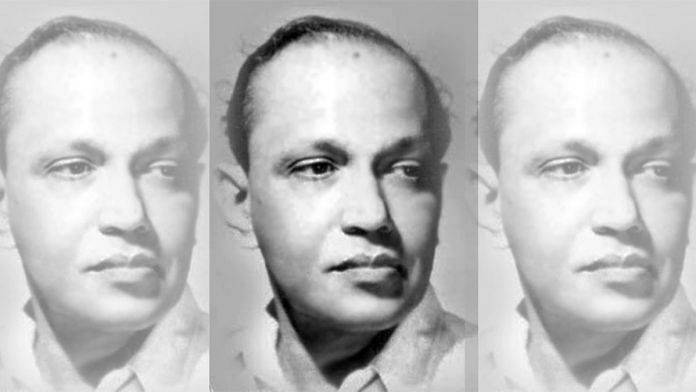Passion, sweeping emotions and love are elevated in Bengali filmmaker Debaki Bose’s movies. He was greatly influenced by M.K. Gandhi’s Non-Cooperation Movement, but it was his knowledge and scholarship of religious saints and their ideologies that formed the basis of his celluloid adventures.
He was often called a ‘cholochitrer sanyasi’ or ‘industry ascetic’ by his colleagues, such as actor Kanan Devi and Bollywood filmmaker Raj Kapoor. Bose was a teetotaler, who dressed in spotless white and ate non-spicy food in the smallest of portions. “But he rode the best of cars, a Mercedes-Benz usually. If you saw the magnificent flight of stairs made of the best Italian marble at his lakeside home in Calcutta [now Kolkata], you’d know what I mean,” his son Debkumar Bose recounted in The Telegraph.
With his films Chandidas (1932), Seeta (1934), and Sagar Sangamey (1959) making waves at international film festivals, Bose made a name in the Indian film industry, his movies managing to reel in eager, thronging crowds.
The novelist Saratchandra Chattopadhyay, who was one of Bose’s mentors, would often ask him why he made films on mythological subjects, and not on any of the social themes that he addressed in his stories. “To reach there, we must first tell stories through devotion and mythology,” was Bose’s response.
Also read: Before PS:1 and Baahubali, Sohrab Modi gave India one of its first big-budget epics
A remarkable life
Bose’s story is filled with sharp turns and rebellious curves.
Born to wealthy lawyer Madhusudan Bose in Bengal’s Burdwan district on 25 November 1898, his initial years were replete with comfort and luxury.
But when he quit Calcutta’s Vidyasagar College in 1920 to join M.K. Gandhi’s Non-Cooperation Movement, his furious parents threw him out of their home, forcing Bose to lead a life fraught with struggle. After serving as a street hawker selling vests and ‘gamchhas’ (thin, coarse cotton towels), Bose decided to leave Calcutta and enter the film industry’s gateways.
He went on to become “India’s highest-paid director, charging Rs 2.5 lakh per film, in [the] 1940s”, quipped his son Debkumar while in conversation with The Indian Express.
Bose was discovered by noted actor and filmmaker Dhiren Ganguly during his stint as an editor at Shakti, Burdwan’s weekly newspaper. A noted film personality, Ganguly met and invited him to write a script and bring it to Calcutta. Titled Flames of Flesh (1930), this script became the first production of British Dominion Films. Bose starred in this film opposite Ganguly’s first wife, Premika Devi.
A tough taskmaster and disciplined director, Bose made his directorial debut with Aparadhi (1931), starring Pramathesh Barua of Barua Pictures. It was the first Indian film to make use of artificial lighting.
His second film, Chandidas (1932), was the first Indian movie to use a background score. “Chandidas had an unprecedented run, and by 1933, it had attained a cult status as cinematic elements and social issues of caste, romantic love, land ownership, widow remarriage, and feminine conservation merged on the screen to create settings for mass recognition,” wrote author and film director Madhuja Mukherjee in Rethinking Popular Cinema in Bengal (1930s–1950s).
Seeta (1934) was the first Indian talkie to be screened at an international film event—the second Venice Film Festival—where it won an honorary diploma, making Debaki Bose the first Indian director to have won an international honour. A box-office hit, Seeta starred ace actors Durga Khote and Prithviraj Kapoor.
Also read: Lion of Bengal A.K. Fazlul Huq eclipsed Jinnah, fought for tenant farmers
Spiritualism and visual effects—a recipe for success
His knowledge and strong affinity for music came from his love for the Vaishnavite and Tagore schools of thought. While his work includes musicals, thrillers and historical films, the mythological projects he undertook stemmed from his spiritual understanding of the world.
According to him, only by focusing on devotional and mythological themes could one reach the path to betterment of the self. This thought percolated into his films, and he came to be known for his contribution to the development of devotional films.
“His forte was his association of Bhakti spiritualism with bazar iconography and emergent melodramatic modes,” Madhuja Mukherjee further contends. Bose’s eye for strongly focused light, ornamental sets, music and dance led him to bag prestigious awards, such as the Sangeet Natak Akademi Award for Film Direction in 1957 and the Padma Shri in 1958. Bose breathed his last on 17 November 1971 in Calcutta, at the age of 73.
(Edited by Zoya Bhatti)



